
Andy Lloyd's Dark Star Blog

Blog 60 (March 2018)
New Simulations Point to Oort Cloud Disturbance in Gemini
The shard-like asteroid from deep space which shot
through the solar system last years, known as 'Oumuamua,
set many an astronomer's heart racing. The
peculiar body was determined to be the first confirmed
interstellar asteroid to have been observed (1).
It's possible, though, that other comets which pursue
so-called hyperbolic orbits (moving fast enough to
escape the solar system) also have an interstellar
origin, rather than having originated from the Oort
Cloud. A team of Spanish astrophysicists, who have
more than a passing interest in the topic of Planet X,
have performed powerful computer simulations to build up
a picture of the trajectories and spatial origins of
various hyperbolic comets (2). The objects they
chose to consider have inbound velocities greater than
1km/s
Image Credit: European Southern Observatory/M. Kornmesser Following adjustment for the Sun's
own movement through space towards the Solar Apex, interstellar
visitors would likely have a more or less random
distribution to their radiants (the position in the sky
from which they came, rather like meteor showers
striking the Earth's atmosphere). The Spanish team
carried
out statistical analysis on the emerging sky maps of
these radiants, and looked for patterns or clusters of
these origin points. Statistically significant patterns
did indeed emerge from the data.
A particularly large source was located in the zodiacal
constellation Gemini. Such a clustering might
indicate a number of possibilities, which the
astrophysicists explore in their paper. One possibility is a close flyby of a
star in the past which could have disrupted the outer
edges of the distant Oort Cloud, sending comets in-bound
towards the Sun. Looking at the tracking of
candidate flybys in the (by Cosmic standards) relatively
recent past, Carlos de la Fuente Marcos, Raul de la Fuente
Marcos & S. J. Aarseth argue that there is a possible
correlation between this cluster of hyperbolic orbit
radiants in Gemini, and a close flyby of a neighbouring
binary red
dwarf system known as Scholz's star some 70,000 years ago
(2). At a current distance of about 20 light
years, Scholz's star may be a close
neighbour to the Sun relatively speaking, but even so it
took a while for it to be discovered. This was probably
because of a combination of
factors: Its proximity to the
Galactic plane, its relative
dimness, and its slow relative
movement across the sky (3). Its
distance was less than a light year 70,000 years ago,
and its rapid movement away from us in the intervening
time helps to explain why it was difficult to detect as
a neighbouring binary star: Its retreating motion
is mostly along our line of sight, making it difficult
to differentiate from background stars.
Other patterns that emerged from an analysis of the
radiants of hyperbolic comets may have the same, or other explanations: "It is
difficult to attribute to mere chance the near
coincidence in terms of timing and position in the sky
between the most recent known stellar fly-by and the
statistically significant overdensity [picked
up in the study]. It is unclear
whether other clusterings present may have the same
origin or be the result of other, not-yet-documented,
stellar fly-bys or perhaps interactions with one or more
unseen perturbers orbiting the Sun well beyond Neptune."
(2) Note that there is another
possibility that they consider: An embedded
planetary object among the comets. Perhaps that is
also a possibility for the Gemini clustering too?
I say this because a quick review of the stellar flyby
hypothesis for Scholz's star picks up the fact that
comets jilted into a Sun-crossing orbit by the visiting
red dwarf would take a very, very long time to get here: "The visitor
would have perturbed comets in the outer Oort cloud, but
those comets’ orbits won’t take them near the sun for
hundreds of thousands, perhaps even millions of years."
(3) Seventy thousand years seems like a
long time, but it may not be enough to witness the
arrival of perturbed long-period comets from the very
outer realms of the solar system. That said, we
are talking about hyperbolic trajectories here, rather
than the usual, calmer parabolic ones. So, perhaps
in the case of these rapidly moving objects, there has
been time enough? My back-of-an-envelope calculation shows that if 1I/'Oumuamua
travelled at the same rough velocity as it did when it was observed over
the last 70.000 years, that it could have covered about 6 light years in
that time. This is, of course, further than the nearest star.
But that would assume that 1I/'Oumuamua was travelling in a straight
line, like a cosmic bullet, for all that time. Even if it was on
that kind of cosmic trajectory, and had come under the influence of the
Sun, then there would be an additional sling-shot effect at play at the
point when we astronomers observed it at perihelion, which would have
speeded its pace up considerably. Further, if this was a
long-period comet which had been given a gravitational nudge by a
passing star, then its motion would not be a simple straight line
velocity through space either. According to Kepler's 3rd law,
comets speed up when closer to the Sun, nearing perihelion, and then
slow down when moving back toward their most distant, aphelion position
(4). So, a perturbed comet from the outer Oort cloud would take a
lot longer to get here than my back-of-an-envelope calculation suggests.
A stellar flyby would not cause a perturbed long-period comet to come
shooting straight at us like a bullet from a gun. Instead, it
would take a more leisurely route around the celestial houses.
If it was not Scholz's star that caused this
particular disturbance in Gemini, then older
stellar flybys could have set these cosmic wheels in
motion. There is something of a back-catalogue of
stars which likely invaded the Sun's personal space at some point
over the last few million years (5). Or perhaps we are returning to
similar arguments put forward by the likes of John
Matese and Daniel Whitmire (re Tyche) (6), John Murray
(7), and even Richard Muller and company (regarding our
old friend 'Nemesis') (8). Dr de la Fuente Marcos
put to it me this way: "As explained in our work, a
significant fraction of the objects with inbound velocities above 1 km/s
have radiants observed projected towards the area we mention in Gemini.
We argue that this may be consistent with the most recent known stellar
encounter, but we do concede that other explanations are possible,
including the presence of yet-to-be found perturbers (bound to the
Sun)." (9) This new work
could stoke up this contentious argument still further,
to the dismay of astronomers who might have hoped this
whole subject had been put to bed long ago. There
is also the potential for more red dwarf flybys emerging from the cosmic
woodwork over time, too. There has been a reliance upon the
Hipparcos astrometric catalogue to make
systematic searches for such objects in our galactic neighbourhood.
The problem with this is that this catalogue
seems to contain a relatively small number of M dwarfs compared
to their known galactic population. Increased use of another
astrometric catalogue, known as Gaia, should pull up more of
these neighbouring, dim red dwarfs which Hipparcos has missed
(3). Perhaps the use of Gaia will bring out more besides,
like ultracool brown dwarfs in our immediate neighbourhood?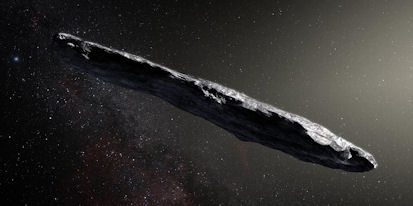
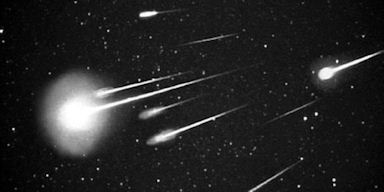
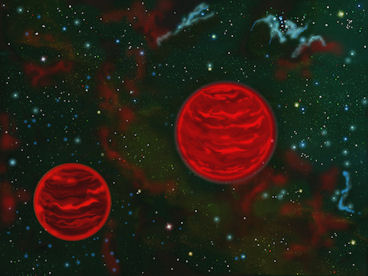
Written by Andy Lloyd, 9th March 2018
References:
1) Andy Lloyd "‘Oumuamua’s Many Cousins" 21 January 2018,
andylloyd.org/darkstarblog58.htm
2) C. de la Fuente Marcos, R. de la Fuente Marcos & S. J. Aarseth "Where the Solar system meets the solar neighbourhood: patterns in the distribution of radiants of observed hyperbolic minor bodies." Monthly Notices of the Royal Astronomical Society: Letters, 476(1): L1–L5, May 2018
3) Eric Mamajek et al "The Closest Known Flyby of a Star to the Solar System" The Astrophysical Journal Letters, 2015, 800(1): L17
4) Anil Ananthaswamy "Stellar intruder’s daring fly-by of the solar system" 19 February 2015
5) Nick Strobel "Kepler's Laws of Planetary Motion" 6 April 2010
6) C. Bailer-Jones "Close encounters of the stellar kind" Astronomy & Astrophysics, 19 February 2015, 575: A35
7) J. Matese, P. Whitman & D. Whitmire "Cometary evidence of a massive body in the outer Oort cloud" Icarus, 1999, 141, pp354-336
8) J. Murray "Arguments for the presence of a distant large undiscovered Solar system planet", Mon. Not. R. Astron. Soc., 1999, 309, pp31-34
9) M. Davis, P. Hut & R. Muller "Extinction of species by periodic comet showers". Nature, 1984, 308 (5961): pp715–717
10) Correspondence from Carlos de la Fuente Marcos, 8 March 2018
Patchy Weather and the L/T Transition
Cooling, older brown dwarfs seem to lose their cloud cover, astronomers have observed (1). Perhaps emulating the aging of a fiery red-headed young man into a cooler, balder gentleman, there seems to be a transition temperature where the fiery locks dissipate. A brown dwarf at the lowest end of the BD mass spectrum, weighing in at 11–12 Jupiter masses, seems unusually red - so much so that it was thought to be a binary object, rather than the planetary-mass object now assumed from its seemingly youthful age. The age of 2MASS J13243553+6358281, at about 150 million years, is deduced from the company it keeps. It travels with the AB Doradus Moving Group (2), and is one of the nearest known planetary-mass objects. Its age and mass place it in the tricky transition phase between the young, hot L-type dwarfs and the older, cool T-type dwarfs; an issue that has been understood theoretically for a while (3). There's quite a lot of context here, so let's explore this transition zone in a little bit of detail.
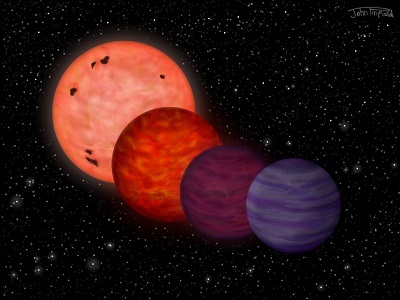
Many sub-brown dwarfs and brown dwarfs rotate quickly, like Jupiter. It was theorised that the hot, dense clouds of the L-dwarfs would eventually thin out and disappear. At some point during this slow, cooling process a variation in cloud cover would be evident (as on Earth). At this transition stage, then, it might be possible that relative short periods of observation of these rotating brown dwarf objects should show a variability in their visible properties with time. Naturally, a tightly bound pair of binary objects needs to be excluded first, as this, too, would create a similar variable appearance as they dance around each other.
In our solar system, Jupiter's complex cloud system shows significant patchiness, where breaks in the cloud cover expose hot patches below. Planet mass objects which are larger than Jupiter would, presumably exhibit more extreme variation still. This was the theory before many brown dwarfs had been spotted, and it seems to have worked out pretty well as more of these objects have come to light, as it were.
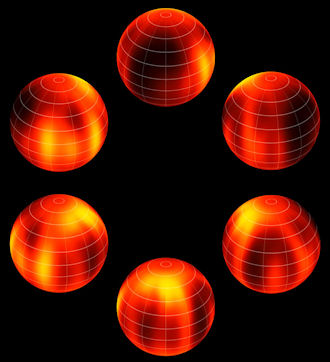
Image Credit: ESO
Nonetheless, the 'L/T transition state' is a variable zone where the properties of 'inbetweener' planetary-mass brown dwarfs remain very difficult to predict. Multiple factors are at play, including complicated chemistry within the clouds and weather variations across the brown dwarf's atmosphere. So when does this patchiness begin? At what temperature; at what age; at what colour, even?
"“L dwarfs” are hot brown dwarfs, which range in effective temperature from ~1400 K to just over 2000 K. They have significant cloud decks—made of iron and rock!—which blanket the surface in a dusty layer. Brown dwarfs cool as they age, and eventually become “T dwarfs.” These T dwarfs are colder brown dwarfs (under ~1200 K). They seem to have clear atmospheres, without a significant cloud layer.
"Objects transition very quickly from being dusty L dwarfs to clear T dwarfs. While brown dwarfs at 1400 K are covered with thick clouds, brown dwarfs that are just 100-200 K cooler are cloud-free. But we don’t know how exactly this happens. Do the clouds just sink down below the visible atmosphere? Do they break up and become patchy?" (4)

Image credit: NASA/JPL-Caltech/University of Western Ontario/Stony Brook U
The colour of a failed star seems to depend significantly upon the properties of the clouds within its atmosphere. Below around 2500 Kelvin, 'hot' brown dwarfs (L-dwarfs) feature 'exotic' dust clouds (5). These clouds are laden with silicate dust (or rock) and literally rain scalding-hot liquid iron.
"Scientists think that the cloudy regions on brown dwarfs take the form of torrential storms, accompanied by winds and, possibly, lightning more violent than that at Jupiter or any other planet in our solar system. However, the brown dwarfs studied so far are too hot for water rain; instead, astronomers believe the rain in these storms, like the clouds themselves, is made of hot sand, molten iron or salts." (6)
Not particularly hospitable, for sure, but this dusty property helps explain their distinctly red colour. As these L-dwarfs cool and age, they gradually turn into the cooler T-dwarfs. It is thought that during this L-T transition phase, the mindwrenchingly powerful iron/rock-laden condensate clouds gradually dissipate, becoming more and more patchy until, eventually, they are gone.
This seems to be the case with the T-dwarf 2MASS J21392676+ 0220226 (2M2139), for instance, whose appearance appears so highly variable as it rotates that observing astronomers concluded that its atmosphere is highly fragmented (7). The way this light variability has been modelled against changes in cloud cover has been neatly illustrated in a short video released by NASA Spitzer (8).
The new research finds another particularly red brown dwarf - one whose age can be relatively well determined. It lies within the L/T transition zone, but is at the lower end of the brown dwarf spectrum, almost being a planetary-mass object (or sub-brown dwarf). So, its properties are helpful for determining the L/T transition point for ultracool dwarfs such as 2MASS J13243553+6358281 - a class of objects which interest me particularly. In this particular case, the transition phase from cloudy to cloud-free seems to occur around 1,150 degrees Kelvin (2), when around 150 million years old.
Written by Andy Lloyd, 4th March 2018
References:
1) Carnegie Institution for Science "When do aging brown dwarfs sweep the clouds away?" 26 February 2018, with thanks to Jim
2) Jonathan Gagné et al "2MASS J13243553+6358281 Is an Early T-type Planetary-mass Object in the AB Doradus Moving Group" February 2018, Astrophysical Journal Letters, Vol. 854, (2)
https://arxiv.org/pdf/1802.00493.pdf
3) Adam Burrows, David Sudarsky & Ivan Hubeny "L and T Dwarf Models and the L to T Transition" The Astrophysical Journal, 2006, Vol. 640, (2),
4) Caroline Morley "Swirling, patchy clouds on a teenage brown dwarf" 28 February 2012
5) Jacqueline Radigan "Weather on Substellar Worlds: Brown Dwarfs" 1 June 2015 on the STSCI blog
6) Whitney Clavin "Stormy Stars? NASA's Spitzer Probes Weather on Brown Dwarfs" 7 January 2014
7) Jacqueline Radigan et al "Large Amplitude Variations of an L/T Transition Brown Dwarf: Multi-wavelength Observations of Patchy, High-Contrast Cloud Features" The Astrophysical Journal, April 2012, Vol. 750 (2),
8) NASA Spitzer "Brown Dwarf Weather Animated Chart" 17 August 2017
Planet Nine Hunting Season Over...For now
Astronomers hoping to verify the existence and location of Planet Nine have been frustrated by atmospheric turbulence. With their preferred observation target of Orion/Taurus now dropping below the skyline as Spring draws near, Dr Mike Brown and his team have had to abandon their hunt for the missing planet in the outer solar system. Dr Brown had managed to gain valuable observation time to use the Subaru telescope located on Hawaii's Mauna Kea mountain. But the atmospheric conditions, including high winds, have rendered the images he took of the candidate zone almost certainly useless (1). He'll now have to wait until the Autumn, when Orion emerges into the skies of the northern hemisphere once again - assuming, that is, that he is successful in getting another slot booked with his favoured telescope.
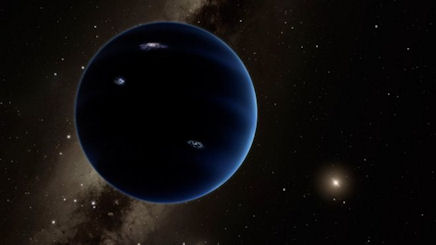
Image credit: Caltech
Dr Brown seemed optimistic that his 'Planet Nine' would be discovered around this time - to solve its 'existential difficulties' as he put it recently (2). But Planet X has proven an elusive object for nigh on 150 years of searching, and it seems that it is not about to give its location away just yet - assuming, of course, that it does actually exist in the first place. In the meantime, ground-based telescopes located in the southern hemisphere could quite easily continue the search over the coming summer. That's if anyone else is actually still looking for it, that is: Although much of the sky has been effectively ruled out as a potential location for Planet Nine, the areas where it may yet lurk remain vast. There's no guarantee that Mike Brown's favoured spot, which has not changed despite various published papers further constraining Planet Nine's position, is correct. Looking for a needle in a haystack involves first locating the right haystack...
There is more bad news on the way for Planet Nine, this time in the form of results from a search for the object in the WISE and NEOWISE databases. The search focuses upon a particular infra-red wavelength, and covers up to 90% of the sky.
"In the present work, we extend our 3.4µm (W1) search to cover more than three quarters of the sky and incorporate four years of WISE observations spanning a seven year time period. This represents the deepest and widest-area WISE search for Planet Nine to date." (3)
Having dismissed a number of possible matches, the astronomers conducting the search concluded that, within those bounds, Planet Nine is simply not there. However, this bleak conclusion is the polar opposite of Brown's statistical analysis of the chances of there being an additional sizeable planet out there. He continues to stand by the theoretical work which underpins the existence of Planet Nine, as described in this month's issue of Scientific American:
"In the months following the announcement, many of Planet Nine’s most fervent seekers (Brown chief among them) predicted it would probably be found by the end of the following winter—that is, by now. In January of this year Brown was still bullish: Based on “statistically rigorous calculations” incorporating all the available data, there is only a one-in-10,000 chance the planet is not out there, waiting to be found. In other words, Brown’s best guess is Planet Nine has a 99.99 percent probability of being real." (4)
I wrote to Mike Brown this week, just to give him the opportunity to say a few words for the new (quite scientific) Dark Star book. As of yet, no reply. This is not uncommon. Most of the astronomers I write to (generally to ask them about aspects of their published work) do not reply. This is frustrating for me, but they're busy people and, well, I'm not exactly a big-time journalist or editor. Also, there's the whole Nibiru thing. Nonetheless, I would welcome the chance at some point to flesh out the reason why I think this object defies efforts to detect it. If nothing else, it would be worth putting these unusual ideas to the test.
Written by Andy Lloyd, 2nd-25th March 2018
References:
1) Andreas Müller "High winds prevented discovery of Planet Nine yet [sic]" 27 February 2018, with thanks to Lee
grenzwissenschaft-aktuell.de article
2) Mike Brown @plutokiller 23 February 2018
3) A. Meisner et al. "A 3pi Search for Planet Nine at 3.4 microns with WISE and NEOWISE." MNRAS pre-print. December 2017. Available at:
4) Lee Billings "Looking for Planet Nine, Astronomers Gaze into the Abyss" 22 March 2018,
scientificamerican.com article
New Horizons Images Distant Kuiper Belt Objects
Remember New Horizons? This spacecraft sent back incredible images of Pluto and its moon Charon a few years ago, before plunging deeper into the Kuiper Belt. NASA have released some new images - this time of two very distant Kuiper Belt Objects, known as 2012 HZ84 and 2012 HE85 (right). To be honest, at the sort of distances involved, they're not much to look at. But these images represent the most distant objects in the solar system every viewed by a space probe (1).
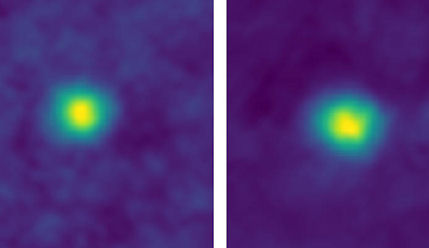
Image credit: NASA/JHUAPL/SwRI
The team operating New Horizons were keen to determine whether these long-distant shots of the two KBOs would show up encircling dust or rings. The presence of such matter might have dire consequences for the probe when it approaches Kuiper Belt objects more closely. At the end of the year, it will achieve just that: a close flyby of 2014 MU69, which is thought to be a binary pair of Kuiper Belt Objects. Should KBOs be found to have extended rings and dust clouds attached to them, then the mission specialists will need to consider how close New Horizons an safely approach them.
This thinking is of some interest to me. I have more than an inkling that dust shrouds are an important property of some very distant objects in the solar system. These KBOs, though, are safely confined within the Sun's Heliosphere, so I don't expect too much unusual gubbins attached to them. But the further out we go, the more likely that things could start to get weird. I'll explain more in my forthcoming new book.
Written by Andy Lloyd, 18th March 2018
References:
1) Bill Keeter "New Horizons Captures Record-Breaking Images in the Kuiper Belt" 8 February 2018,

You can keep informed of updates by following me on Twitter:
![]()
Or like my Facebook Page: https://www.facebook.com/darkstarandylloyd